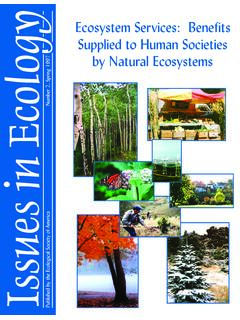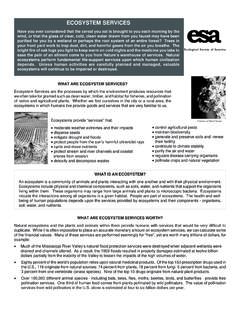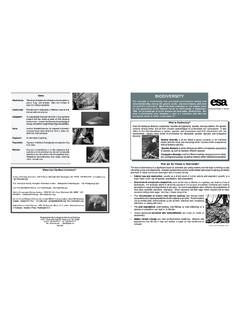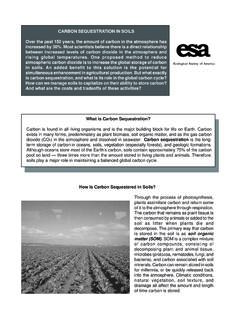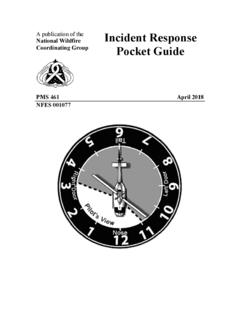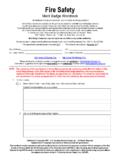Transcription of FIRE ECOLOGY - ESA
1 fire ECOLOGYP erhaps the image most often associated with wildland fire isone of destruction. While it is true that fire has a great potentialfor the destruction of homes, wildlife, and even human life, fireis just one of many natural forces within BehaviorFire behavior is most often described by intensity and spread. Many factors influence this factors that influence intensity are available fuel, moisture and temperature, fuel composition,wind, and topography. Available fuel is quantified by size and arrangement. The more available fuel,the more intense the fire and cool, moist fuels combust more slowly than hot, dry fuels. Fuel compositioncan make a fire more or less intense. Oils and resins increase the heat yield of the reaction andcause a fire to burn intensely whereas other chemical factors, such as high concentrations of miner-als, can reduce flammability. Wind increases oxygen supply, convects heat and can produce spotfires from fragments that blow down-wind.
2 Finally, topography effects intensity. A fire ignited on thetop of a slope is likely to spread slowly as it burns downhill, whereas a fire at the bottom of a slope willstart rapidly and gain momentum as it burns uphill because warm air rises and preheats uphill of the factors that affect intensity also affect the rate of spread. For example, fires in dry, windyconditions with abundant fuel spread rapidly. Fuel continuity and topography also play a role inspread. Topographic features such as streams and lakes can create firebreaks, thus influencingthe distribution of burns across landscapes. Finally, the composition of plant communities affectsspread, as some species are more flammable than is fire ECOLOGY ? fire is a natural component of many ecosystems, which include plants and animals that interact withone another and with their physical environment. fire ECOLOGY examines the role of fire in ecologists study the origins of fire , what influences spread and intensity, fire s relationship withecosystems, and how controlled fires can be used to maintain ecosystem Physical and Chemical Nature of FireFor fuel to ignite it must be heated in the presence of oxygento the ignition point or kindling temperature.
3 Wood must reachabout 800 degrees F to burst into flame. As the wood isbeing heated to this point it dries as water, oils, and resinsare boiled away. The chemical structure of the fuel is brokendown and flammable gases are produced. The ignition ofthese flammable gases is known as flaming combustion transforms the surface of the wood tocharcoal. At cooler temperatures, glowing combustion con-sumes charcoal, producing ash, water, and carbon factors such as fuel, weather, topography, and fire his-tory influence the probability of ignition and near Sula Complex fire , MontanaPhoto Courtesy of Alaskan Type I IncidentManagement TeamEcological Society of AmericaThe Effects of fire on EcosystemsThere is much yet to be learned about how wildland fire affects ecosystems. This is in part becauseeach fire and each ecosystem has unique properties. However, some generalities can be PatternsWildland fires create a mixture of totally burned,partially burned, and unburned sections calleda burn mosaic.
4 The varying degrees of burnare a result of many factors including windshifts, daily temperature changes, moisturelevels, and varying chemical composition of thevegetation. The burn mosaic results invaried regrowth rates that creates a vegeta-tion ConditionsWildland fires can be both a detriment and abenefit to soil. The soil can become more nu-trient-rich after a fire due to the high mineralcontent of the ash and charcoal and also dueto the warm, moist conditions that increase mi-crobial activity. The intense heat can alsocause soil particles to become water-repellant,causing rainwater to run off. As the water runsoff it can carry soil particles with it and lead PopulationsSome animals will perish in wildland fires, especially small animals, insects, and older and weakerindividuals. However, fire has a greater affect on habitat than on individuals. While the vast majorityof large mammals are able to flee fires, populations often suffer substantial losses in the monthsfollowing a fire due to a loss of food sources.
5 Food sources are scarce because of the fire itself andalso because most natural fires occur shortly before winter. These habitat changes allow otheranimals to thrive. Scavenging animals find an increased abundance of food sources and predatoryanimals may benefit from reduced forest cover which makes prey more visible. Nutrient-rich newgrowth also benefits many animals and animals such as deer will even eat the nutrient-rich charcoaland ashes. Birds also thrive on increased seed availability and nesting sites in PopulationsVegetation composition is one factor that determines how a fire behaves. The fire behavior in turndetermines the extent to which the plant populations are affected. The more intense the fire , themore vegetation is killed. The initial vegetation losses may look harsh, but the reduced number oftrees and shrubs minimize competition among the surviving individuals.
6 The organisms that survivethe fire gain more access to nutrients, light, and water. Plants may exhibit increased growth, benefit-ing from the additional minerals in the soil as a result of the fire . fire may also rid some plants of theirparasites, increasing plant health. For example, a high-intensity fire kills dwarf mistletoe, a parasiticplant of the lodgepole. Some plant species have adaptations that allow them to survive, thrive, andeven require fire for survival. The giant sequoia can produce bark that is 2 feet thick as protectionfrom fire . Other plants such as the chaparral snowbush require the heat of wildland fires to cracktheir seed in a Burned ForestPhoto Courtesy of US Forest ServiceFire RegimesFire regimes are the patterns of wildland fires that include factors such as frequency, extent, intensity,type, and season. Regimes vary by ecosystem because each ecosystem has a different compositionand structure determined by climate conditions, vegetation types, and ignition sources.
7 Humans havealtered many aspects of natural fire regimes over time. Currently, ecologists are studying evidence totry to determine historical fire records or natural fire regimes. Techniques include sampling fire scarson trees for evidence of a sequence of fires in the growth rings, sampling lake and reservoir sedimentsfor extreme or unusual runoff events, using written and oral histories, and extrapolating from currentpatterns of weather, fuel build-up and lightning fires. Understanding natural fire regimes should leadto the most appropriate resource management policies. The variety of ecosystems and regimesdictates that there should be a variety of techniques and practices in any comprehensive managementpolicy. One solution does not fit Influence on wildland FireThe way a fire operates is largely determined by a region swildlife. Altering these biotic components impacts the fire seffects.
8 Humans have had one of the greatest influenceson the biota of ecosystems. Native Americans and earlysettlers used fire extensively in their landmanagement practices. Today, we clear vegetation for farm-ing, homes, commercial buildings, and roads. We intro-duce nonnative species. We use forests to harvest influences are countless. As a result, it is impossible tofully understand the extent to which humans have alterednatural fire regimes. This makes fire management a com-plex and often controversial PineThe Lodgepole Pine (Pinus contorta) is a dominant tree of the northernUnited States and Canada. A lodgepole stand may live 250 to 400 the first century of the stand s existence surface fires are unable toclimb into the forest canopy because the lower branches of a lodgepole dieand drop-off as the tree grows taller. Slowly shade-tolerant spruces andfirs start to grow on the dark floor of the stand, blocking out the sun andpreventing lodgepoles from sprouting.
9 Eventually spruces and firs woulddominate if there were no forest fires. However lightning usually ignites afire that destroys the stand. After a fire , lodgepole pines are often the firsttrees to reappear because the bare, sunlit soil that remains after a fire isideal for lodgepole seedling growth. Lodgepoles also have special seroti-nous cones that are coated with a hard waxy substance. fire melts thiscoating, allowing thousands of seeds to be released. The Lodgepole Pineis just one of many species that is dependent upon PinePhoto Courtesy of Neva Snell,CA Academy of SciencesLogging Truck in UtahPhoto Courtesy of US Forest ServiceFor More InformationAssociation for fire ECOLOGY , States Department of Agriculture, Forest Service, States Department of the Interior, Fish & Wildlife Service, States Department of the Interior, Bureau of Land Management, National Park Service, Interagency fire Center, Timbers Research Station, by the Ecological Society of America1707 H Street, NW, Suite 400, Washington, DC 20006, 2002 Prescribed Burns and the Reintroduction of FireOne of the first fire management practices of the United States government was one of total firesuppression.
10 In the 1930s researchers began to challenge this policy and argue that in some regionsfire was an element essential for ecosystems tothrive. In the 1950s and 1960s national parks andforests began to experiment with prescribedburning, the practice of intentionally ignitingwildland fires and permitting naturally occurringfires to goal of prescribed burns is to begin to restorethe natural fire regime in areas where firesuppression has been the practice. Ecosystemswhere fire has been suppressed may take sometime and several fires to restore a natural , managers attempt to allow only low-intensity fires to burn in order to recondition theecosystem to fire . Where fuels are quite dense or conditions such as high winds may cause high-intensity fires, fires continue to be suppressed. This strict management makes prescribed burns mostuseful in ecosystems where the past fire regime was one of low-intensity fires.
